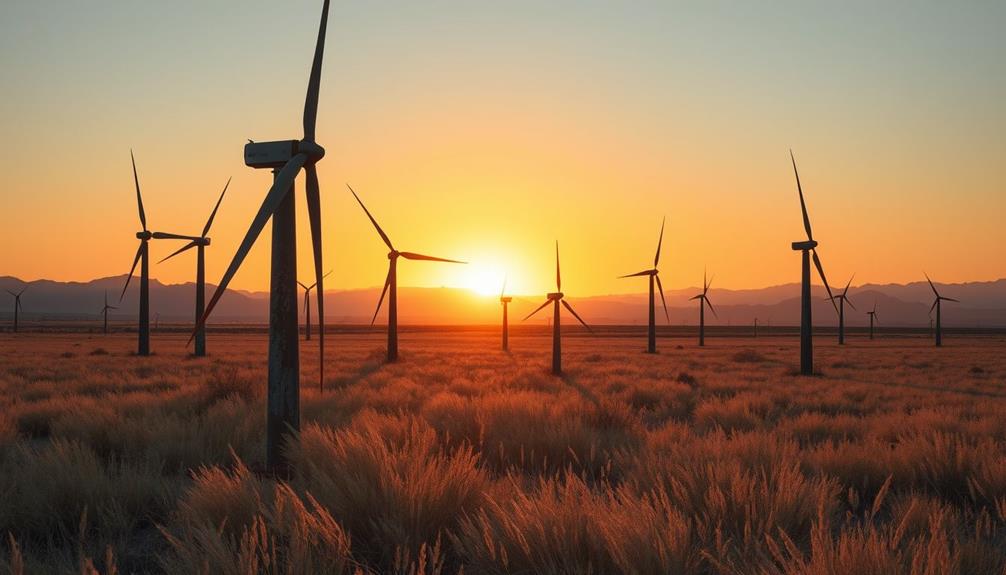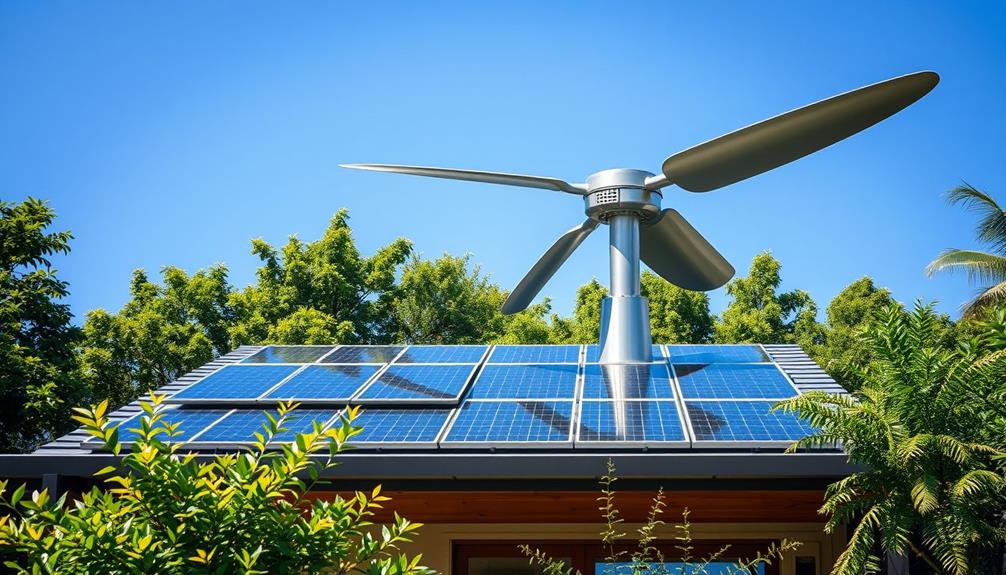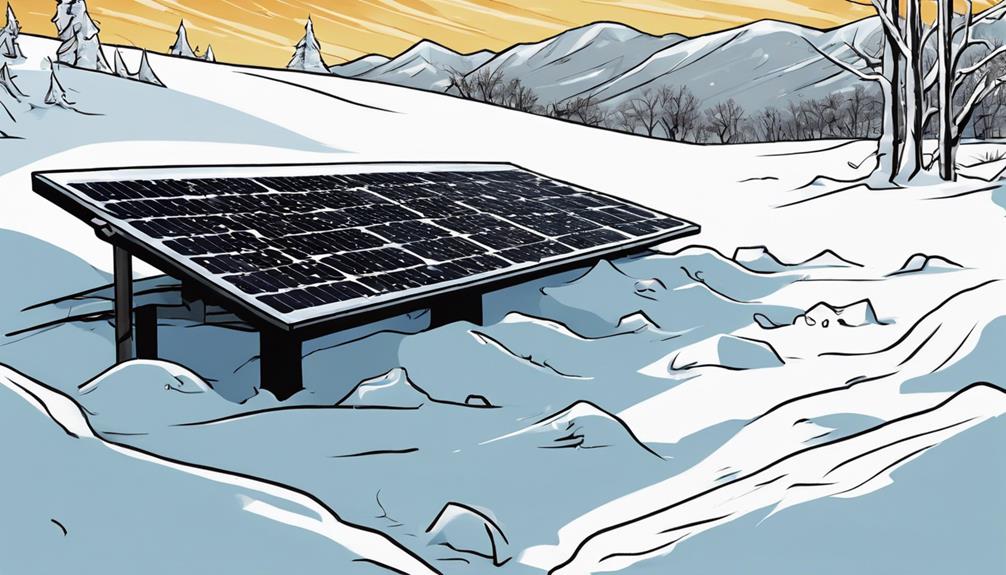You might be surprised to learn that old wind turbine blades often end up in landfills, raising serious environmental concerns. These massive structures, made from non-biodegradable materials, can take centuries to degrade. In the U.S., thousands of blades are stockpiled, especially in places like Sweetwater, Texas. While about 85% of turbine components are recyclable, blades present a unique challenge due to their size and materials. The need for innovative recycling solutions is becoming urgent as projections show millions of tons of waste by 2050. Interested in discovering how technology is shaping the future of blade disposal?
Key Takeaways
- Decommissioned wind turbine blades often end up in landfills, where they can take centuries to degrade.
- Around 4,000 retired blades are stockpiled in Sweetwater, Texas, highlighting the accumulation of waste.
- Current recycling practices include shredding blades for cement production, but large-scale solutions remain untested.
- The UK discards over 100,000 tons of turbine blades annually, emphasizing a need for sustainable disposal methods.
- Emerging policies, like the EU's proposed landfill ban by 2025, aim to promote better waste management for turbine blades.
Wind Energy Growth Overview

The growth of wind energy has been nothing short of remarkable, especially as it recently generated 69% of the UK's electricity in November 2023. This surge underscores wind power's vital role in the global renewable energy landscape.
With a near 50% increase in new renewable capacity in 2023, it's clear that clean energy sources are rapidly expanding. According to the International Energy Agency, renewables now account for nearly one-third of global electricity production, and they're projected to surpass hydropower, coal, and nuclear energy by 2026.
Additionally, incorporating advanced technology in energy systems can enhance efficiency and sustainability, thereby supporting the growth of renewable sources like wind power features of the ultimate heat pump.
The global wind power market, valued at over $99 billion in 2021, is expected to grow at an annual rate of 6.5% throughout the decade. This booming industry isn't without its challenges, particularly concerning the disposal of used turbine blades.
As you may know, about 3,000 to 9,000 wind turbine blades are expected to retire annually in the US over the next five years. Addressing these challenges, including recycling the blades, is vital for the sustainability of wind energy.
As we embrace wind power, it's important to take into account the entire lifecycle of these critical components.
The Issue of Wind Turbine Waste

As wind energy continues to grow, you're faced with the pressing issue of wind turbine waste.
The challenges of recycling these massive fiberglass blades complicate disposal efforts, leading to significant environmental concerns.
Weight of Wind Turbine Blades varies widely, which can exacerbate the disposal problem as the sheer size and weight complicate transportation and logistics.
With projections indicating millions of tons of waste by 2050, it's clear we need to rethink our approach to managing this byproduct of renewable energy.
Recycling Challenges Faced
Wind turbine blades, often seen as symbols of renewable energy, present a significant recycling challenge once they reach the end of their life cycle. These blades, exceeding 300 feet in length and weighing up to 8 tons, are primarily made of composite materials like fiberglass and resin. This makes recycling them a complicated task.
In 2021 alone, around 8,000 blades were decommissioned in the U.S., and by 2040, we could face a cumulative mass of 1.5 million metric tons of blade waste. The challenge of managing this waste aligns with the importance of budgeting for sustainable solutions, as investing in recycling technologies could prove financially beneficial in the long run.
While about 85% of turbine components can be recycled, the robust structure of the blades complicates disposal efforts. Currently, many blades end up in landfills due to lower disposal costs in the U.S., despite European countries moving to ban such practices.
Innovative recycling options are being explored, such as converting the blades into cement or repurposing them for playgrounds and shelters, but effective large-scale recycling processes remain untested. As you consider the future of green energy, the question of what to do with decommissioned blades becomes increasingly pressing.
Environmental Impact Concerns
Managing the environmental impact of wind turbine waste is becoming an urgent concern as the industry grows. With around 4,000 decommissioned blades stockpiled in Sweetwater, Texas, the challenge of disposal is evident. These massive structures can exceed 300 feet in length and weigh up to 8 tons, complicating their disposal.
Currently, many end up in landfills, where their non-biodegradable fiberglass can take centuries to degrade. This not only occupies valuable land but also raises significant concerns about environmental pollution, similar to the issues faced in other sectors such as precious metals investing, where transparency and sustainability are increasingly prioritized transparent fee structure.
The European Union has recognized this issue and plans to ban the landfill disposal of used turbine blades by 2025, underscoring the need for sustainable waste management solutions.
As projections indicate that 2 million tons of wind turbine blade waste could be generated annually by 2050, the urgency for effective recycling methods intensifies. You can see that without proactive measures, the environmental impact of wind turbine waste will continue to grow.
Emphasizing recycling and innovative disposal techniques is essential to mitigate these concerns and guarantee a greener future for wind energy.
Current Disposal Practices

When it comes to disposing of wind turbine blades, landfills are the go-to solution, but this method poses significant challenges.
With blades taking centuries to degrade, the need for innovative recycling solutions has never been more urgent.
As emerging technologies are starting to reshape the landscape of blade disposal, it's essential to explore sustainable practices that could mitigate the environmental impact associated with traditional disposal methods.
As you'll see, emerging technologies are starting to reshape the landscape of blade disposal.
Landfill Disposal Challenges
Decommissioned wind turbine blades pose a significant challenge in landfill disposal, as their sheer size and weight complicate waste management efforts. Often exceeding 300 feet in length and weighing up to 8 tons, these blades are primarily buried in landfills, where they can take centuries to degrade.
As of 2021, around 8,000 blades were decommissioned in the US, contributing to a projected 1.5 million metric tons of blade waste by 2040. The environmental impact is further exacerbated by the fact that these materials aren't easily recyclable, leading to increased scrutiny over cold medications overview in waste management practices.
Landfills like the Casper Regional Landfill in Wyoming have become repositories for discarded blades, housing about 870 of them due to limited recycling options. This disposal method raises serious environmental concerns, as burying the blades can lead to potential leaching of harmful materials into the soil and groundwater.
Municipal landfills are increasingly the default solution for decommissioned wind turbine blades, which contradicts the sustainability goals of wind energy initiatives. While the push for clean energy continues, the lack of effective recycling options highlights a significant gap in the waste management infrastructure.
Addressing these landfill disposal challenges is vital for ensuring that the benefits of wind energy aren't overshadowed by growing waste problems.
Recycling Innovations Emerging
As the wind energy sector expands, recycling innovations are emerging to tackle the growing issue of turbine blade waste. Currently, about 4,000 decommissioned wind turbine blades sit in landfills like those in Sweetwater, Texas, contributing to significant environmental concerns due to their non-biodegradable materials.
With an estimated 2 million tons of wind turbine blade waste projected annually by 2050, the urgency for effective recycling solutions is clear. Design thinking leadership can play a vital role in fostering innovative approaches to this pressing challenge.
While companies like Global Fiberglass Solutions promise to turn composite materials into recyclable blades, skepticism remains due to their unfulfilled commitments. The challenge lies in the complex structure of these blades, primarily made of fiberglass and resin, which makes recycling difficult.
However, innovative approaches are being explored to separate resins from fibers, although no large-scale, effective recycling processes exist yet.
Successful initiatives in Denmark, Ireland, and the Netherlands offer hope, yet they remain limited in scope. Extensive solutions are needed to address the increasing volume of decommissioned blades and to guarantee a sustainable future for wind energy.
The industry must prioritize technological advancements to transform waste into valuable resources.
Recycling Challenges and Innovations

The challenge of recycling wind turbine blades has become increasingly urgent as thousands are decommissioned each year. With approximately 8,000 blades retired in the US in 2021 alone, we're looking at a staggering 1.5 million metric tons of material projected by 2040.
The primary materials used—fiberglass and thermoset resins—make recycling difficult, as they don't decompose easily. This issue highlights the importance of sustainability in various industries, similar to how Gold IRAs provide a hedge against economic instability and inflation challenges.
Current recycling solutions are limited but promising. For instance, some companies are shredding blades for use in cement production, reducing carbon dioxide emissions by 27%.
However, innovative reuse applications are emerging. Consider:
- Transforming blades into playground equipment
- Creating public benches
- Developing artistic installations
These ideas showcase the potential of wind turbine materials if effective recycling solutions can be established.
General Electric and other companies are exploring methods to improve the recycling process, but skepticism remains about the feasibility.
It's critical we tackle these recycling challenges head-on to guarantee the sustainability of wind energy. By finding innovative reuse options and improving current methods, we can better manage the lifecycle of wind turbines and their blades for a cleaner future.
Economic Implications of Blade Disposal
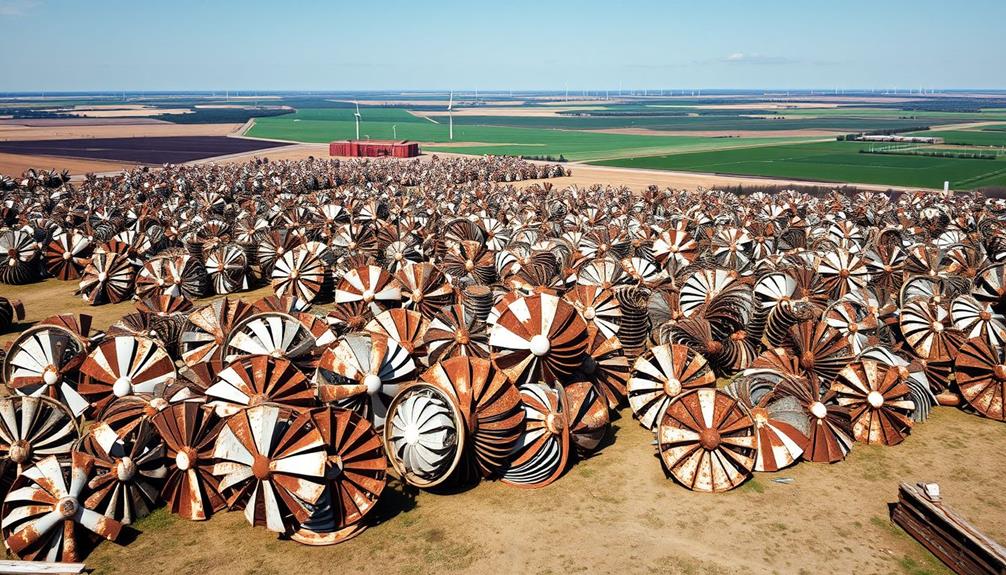
Wind energy companies face significant economic implications due to the disposal of wind turbine blades, which can lead to substantial costs in waste management. With projections indicating up to 2 million tons of blade waste produced annually by 2050, these companies must navigate complex financial landscapes. Lawsuits, like the one filed by General Electric against recycling firms, expose the legal and financial risks tied to blade disposal contracts.
| Economic Implications | Details |
|---|---|
| Disposal Costs | High costs associated with waste management and recycling solutions. |
| Public Nuisance Designations | Local jurisdictions may classify stockpiles as nuisances, incurring fines. |
| Investment in Sustainable Tech | Driving need for innovation can boost job creation but requires upfront investment. |
Sweetwater County's declaration of discarded blades as a public nuisance underscores the financial repercussions, with over $1 million in unpaid rent owed by recycling companies. As European bans on landfilling blades push for recycling, U.S. companies face lower disposal costs, complicating the shift to sustainable practices in the industry.
Environmental Impact of Landfilling
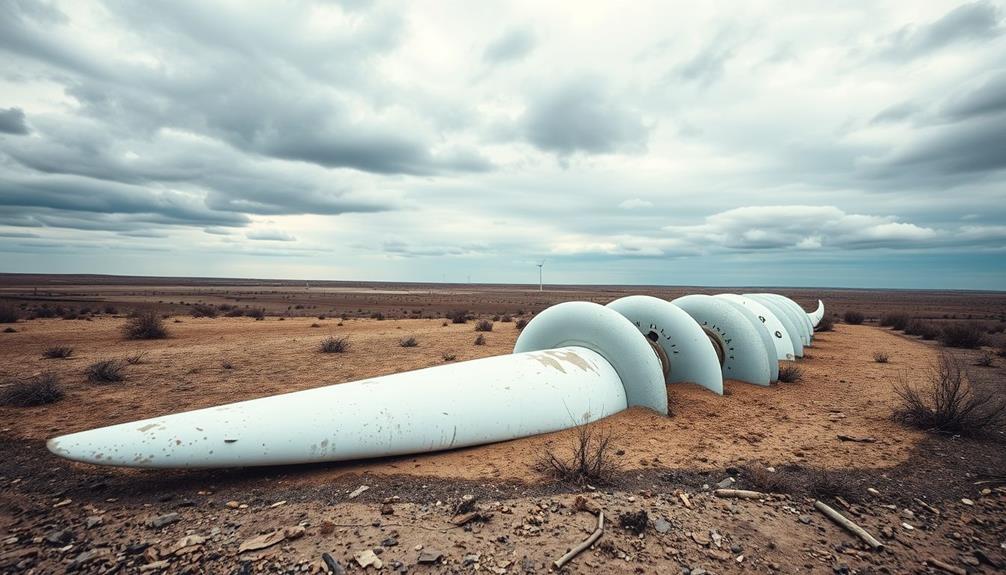
Landfilling decommissioned wind turbine blades poses significant environmental challenges that can't be ignored. As the number of used blades increases, so does the impact of their disposal. With around 4,000 blades currently stored in Sweetwater, Texas, and predictions of 2 million tons needing disposal annually by 2050, the situation is dire.
Here are some key environmental concerns associated with landfilling:
- Fiberglass composition: These blades can take centuries to degrade, creating long-term waste issues. The presence of such materials in landfills raises concerns similar to those seen with the effectiveness of home security systems in preventing long-term risks.
- Potential pollution: Harmful chemicals can leach into soil and groundwater, exacerbating existing pollution problems.
- Growing waste management challenges: The UK alone discards over 100,000 tons of blades annually, highlighting the urgent need for sustainable solutions.
The environmental impact of landfilling wind turbine blades is significant. While they're recyclable, current disposal practices often neglect this potential, contributing to a cycle of waste.
As the European Union prepares for a landfill ban on used turbine blades by 2025, it's essential to rethink our approach to disposal. We need sustainable alternatives that protect our environment and guarantee the renewable energy sector doesn't contribute to its own waste crisis.
Policy and Regulatory Considerations
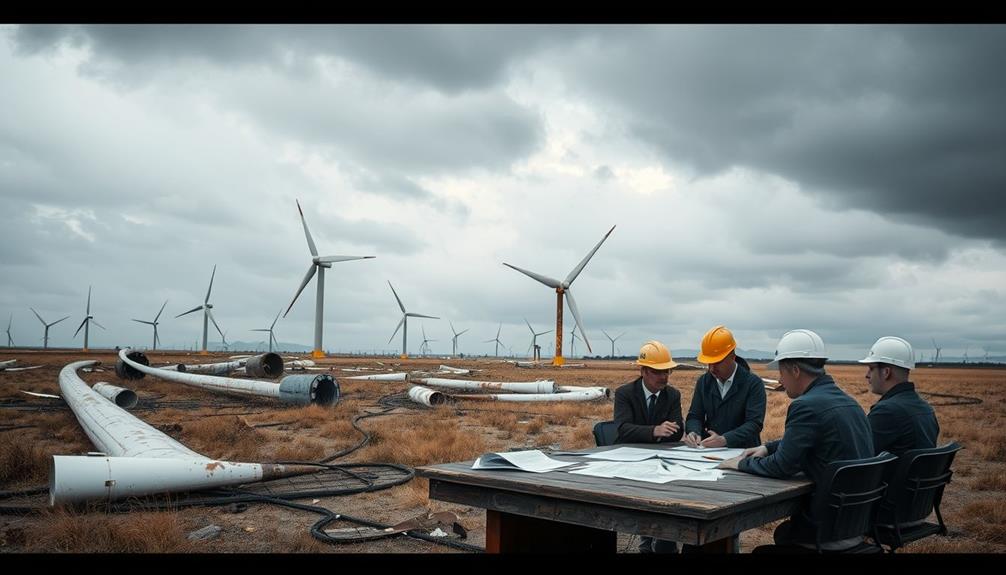
As the wind energy sector grows, steering through the complex landscape of policy and regulations becomes essential for managing turbine blade waste effectively. Current regulations lack specific guidelines for disposing of wind turbine blades, which has led to increased calls for stricter environmental policies.
The increasing focus on sustainability and responsible investing in sectors like renewable energy has prompted stakeholders to advocate for more thorough waste management strategies. Several European countries, like Germany and the Netherlands, have already implemented bans on landfilling these blades, and more nations are expected to follow suit by 2025 due to rising disposal costs and limited landfill space increased focus on sustainability.
In the U.S., incidents like the fines against Global Fiberglass Solutions by the Texas Commission on Environmental Quality underscore the need for enhanced regulatory oversight. Without clear waste management strategies, the risk of illegal storage and environmental harm increases.
Stakeholder engagement is imperative; advocating for state and federal incentives can promote recycling efforts and guarantee that extensive policies are developed.
The proposed EU landfill ban reflects a growing trend towards enforcing recycling requirements, addressing the waste challenges posed by wind energy technologies. By pushing for effective regulations, you can help steer the industry toward more sustainable practices in managing turbine blade waste.
Future of Wind Blade Recycling
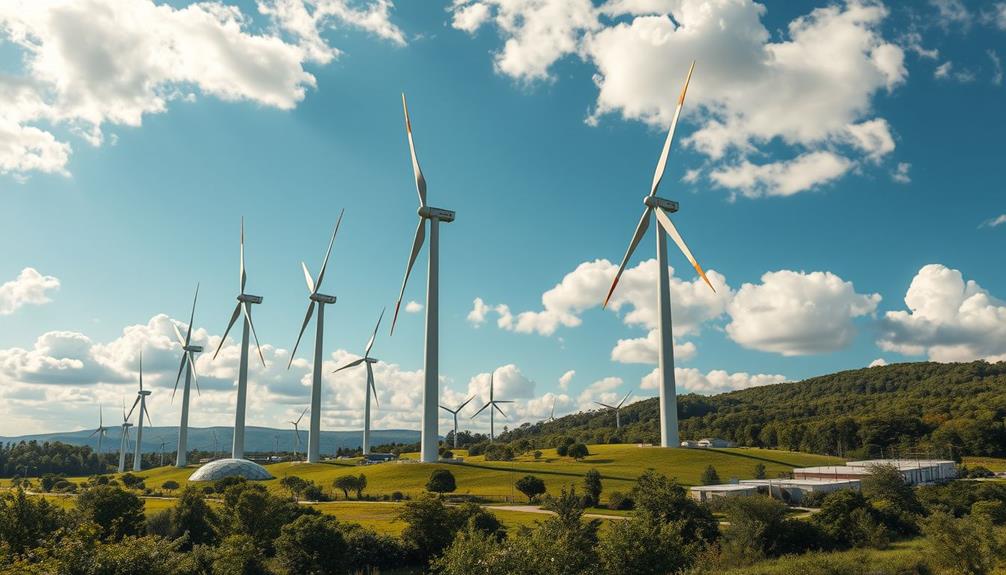
The future of wind blade recycling hinges on innovative solutions and advancements in technology. With approximately 8,000 wind turbine blades decommissioned in the US in 2021, and projections suggesting up to 2 million tons of waste annually by 2050, the urgency for effective recycling methods is clear.
Current recycling technologies struggle with the difficult-to-recycle composite materials that make up these blades. However, companies like Siemens Gamesa are pioneering research into recyclable epoxy resins, aiming to create inherently recyclable materials.
Additionally, innovative repurposing applications are emerging, allowing decommissioned blades to find new life instead of ending up in landfills. Some of these applications include:
- Converting blades into construction materials
- Transforming them into playground equipment
- Using them for artistic installations
As regulatory changes, like the proposed EU landfill ban on used turbine blades by 2025, take effect, the demand for sustainable technologies will only increase.
Frequently Asked Questions
Where Do Old Wind Turbine Blades Go?
When old wind turbine blades reach the end of their service, they typically end up in landfills. Their fiberglass materials make recycling challenging, prompting concerns about environmental impacts and the growing waste generated by the wind energy industry.
Do Wind Turbine Blades End up in Landfill?
Yes, wind turbine blades often end up in landfills. They're too large and difficult to recycle efficiently, leading to significant environmental concerns. Finding sustainable disposal methods is essential as the number of decommissioned blades grows.
What Happens to End of Life Wind Turbine Blades?
You might think end-of-life wind turbine blades just vanish, but they often languish in landfills for centuries. Recycling's a tough nut to crack, leaving us scrambling for innovative solutions to tackle this growing problem. The shocking truth about wind energy waste is that the current methods of disposal are not sustainable. With the rapid expansion of wind energy, the issue of how to responsibly dispose of end-of-life turbine blades is becoming increasingly urgent. The environmental impact of these massive blades sitting in landfills for centuries is a problem we cannot afford to ignore any longer. It’s clear that finding a solution for recycling or repurposing wind turbine blades is a critical challenge for the renewable energy industry.
What Is the Lifespan of Wind Turbine Blades?
Wind turbine blades usually last around 20 to 25 years. After that, their efficiency declines considerably, necessitating decommissioning. As demand for wind energy grows, many blades will reach their end-of-life sooner than expected.
Conclusion
As the wind energy sector continues to soar, it's essential to address the looming issue of turbine blade disposal. Like a shipwreck on a forgotten shore, these massive structures are left to decay in landfills, posing environmental risks. By embracing innovative recycling methods and crafting thoughtful policies, we can transform waste into valuable resources, ensuring that the green revolution doesn't leave behind a trail of discarded giants. The future of wind blade recycling holds the promise of a cleaner, sustainable tomorrow.
